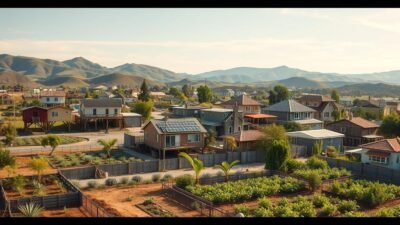Our impact on Earth’s ecosystems is massive. We’re reshaping landscapes, altering climate patterns, and changing life on our planet. Our footprint extends far beyond what we can see.
Human activities are straining global ecosystems. We demand 70% more from ecosystems than they can regenerate. This imbalance shows we urgently need to address our impact.
Our influence is huge. Domesticated chickens now outweigh all wild birds by three times. Cattle and pigs exceed wild mammals’ biomass by 14 times. These facts show how we’ve changed Earth’s biological makeup.
Since the 18th century, the world’s population has grown sevenfold. This growth has put massive pressure on natural resources. Our unsustainable habits have led to huge losses in wildlife.
We’ve lost 83% of all wild mammals globally. Half of all plant species are gone too. Every part of human civilization affects the environment.
We need to understand how our actions shape Earth’s future. This knowledge is key to developing sustainable solutions for our planet.
Key Takeaways
- Human demand on ecosystems is 70% higher than their regeneration rate
- Domesticated animals now significantly outweigh their wild counterparts
- 83% of wild mammals and half of plant species have been lost due to human activities
- Population growth and overconsumption are key drivers of ecological threats
- Understanding human impact is crucial for developing sustainable solutions
Introduction to Anthropogenic Activities
Human actions have profoundly shaped our planet. ‘Anthropogenic’ refers to effects or objects resulting from human activity. This concept helps us grasp our impact on Earth’s ecosystems.
Defining Anthropogenic Activities
Anthropogenic activities include all human-induced environmental changes. These range from urbanization and agriculture to industrial processes. Such activities often lead to environmental degradation and ecosystem disruption.
Historical Context and Evolution
The human-nature relationship has changed dramatically over time. Early civilizations had limited impact on their surroundings. As populations grew and technology advanced, our influence expanded rapidly.
| Year | Global Population | Key Environmental Impact |
|---|---|---|
| 1947 | 300 million | Limited environmental impact |
| 2023 | Over 1 billion | Significant ecosystem disruption |
Today, human activities affect every corner of the globe. Coastal zones make up 18% of Earth’s surface. They host 70% of the world’s cities and 25% of the global population.
These areas face intense pressure from urbanization and pollution. The scale of human impact is staggering.
In India, industries generate 33 million cubic meters of solid waste annually. Pesticide use increases by 15% each year. These figures highlight the urgent need to address ecosystem disruption.
“The human species, while buffered against environmental immediacies by technology and culture, is ultimately fully dependent on the flow of ecosystem services.” – Gretchen Daily, Stanford University
Understanding anthropogenic activities is crucial for developing sustainable solutions. It helps us mitigate environmental degradation caused by human actions.
Types of Anthropogenic Activities
Human activities cause significant changes in ecosystems worldwide. These actions lead to global ecosystem degradation. They alter natural habitats and affect biodiversity around the world.
Urbanization and Land Use
Urban growth rapidly changes landscapes, causing habitat loss. In China’s Xinjiang region, city expansion affects unique ecosystems. This area spans 1.60 million km² with annual temperatures between 9°C and 12°C.
The region experiences 2550 to 3500 annual sunshine hours. It also has 180 to 220 frost-free days yearly. Urban growth impacts these delicate ecosystems.
Agriculture Practices
Farming greatly affects ecosystem health. Xinjiang’s arid climate poses challenges for agriculture. Annual rainfall ranges from below 100mm to 200mm in this region.
High evaporation rates of 1500-3400mm further strain water resources. These conditions make sustainable farming difficult in such areas.
Industrialization
Industrial growth significantly impacts ecosystems. Studies show climate change causes 54% of changes in vegetation productivity. The remaining changes likely result from human activities, including industrialization.
| Region | Protected Area | Impact on Ecosystem |
|---|---|---|
| Egypt | 15% of total area | 95% desert ecosystem |
| Tunisia | 13 years protection | 58.3% increase in total cover |
| Saudi Arabia | 30 years minimal activity | Increased plant species diversity |
These human activities contribute to land degradation worldwide. They affect over 25% of the global population. Understanding these impacts is vital for conservation efforts.
Developing effective strategies can help reduce global ecosystem degradation. Protecting natural habitats is crucial for maintaining biodiversity and ecosystem health.
The Impact of Urbanization on Ecosystems
Urban growth changes natural areas into cities, affecting ecosystems. This shift impacts Earth’s ecological balance. Cities bring both problems and solutions for the environment.
Habitat Destruction
City expansion often destroys animal homes. Over half the world’s people now live in cities. This puts pressure on nature.
Urban growth can wipe out up to 50% of species in some areas. This loss threatens biodiversity and upsets delicate natural balances.
Urban Heat Islands
Cities create their own warmer climates called urban heat islands. These areas can be 1 to 7 degrees Celsius hotter than nearby countryside.
The extra heat changes wildlife behavior and plant growth. Cities also produce about 70% of global greenhouse gases, affecting climate patterns.
Changes in Biodiversity
City life greatly changes local plant and animal life. Some species struggle while others thrive in urban settings.
City gardens can boost pollinator numbers by up to 30%. This shows how good planning helps nature. However, cities may see 50% more invasive species than natural areas.
| Aspect | Impact | Percentage |
|---|---|---|
| Global Urban Population | Increasing urbanization | Over 50% |
| Species Loss | Due to land conversion | Up to 50% |
| Urban Heat Island Effect | Temperature increase | 1-7°C |
| Pollinator Increase | In urban gardens | Up to 30% |
| Invasive Species Growth | In urban areas | Over 50% |
Knowing these effects helps create better city growth plans. We must balance urban needs with nature’s health. This knowledge can lead to more eco-friendly city development.
Agriculture and Its Ecological Footprint
Agriculture feeds the world but leaves a big ecological footprint. It’s a prime example of human impact on global ecosystems. Let’s explore the key aspects of this impact.
Pesticide Use and Chemical Pollutants
Pesticides in agriculture pose serious environmental risks. Over 60% of global farmland risks pollution from multiple pesticide ingredients. This threatens biodiversity, especially in high-biodiversity areas.
In these regions, 30% of farmland faces “high risk” of pesticide exposure. This puts many species at risk of harm or extinction.
Deforestation for Farmland
Expanding farmland often leads to deforestation. This contributes to climate change and biodiversity loss. Agriculture is responsible for about 14.5% of global greenhouse gas emissions.
The food system accounts for 21-37% of annual emissions. This highlights the significant impact of land-use changes for agriculture.
Sustainable Farming Practices
Sustainable farming practices are crucial to address these challenges. The UN’s Sustainable Development Goal 2 aims to promote sustainable agriculture globally. This includes reducing pesticide use and implementing water-efficient irrigation systems.
Adopting regenerative farming techniques can also help. These methods minimize agriculture’s ecological footprint and protect our planet’s resources.
| Agricultural Impact | Percentage |
|---|---|
| Global greenhouse gas emissions from animal agriculture | 14.5% |
| Global freshwater withdrawals for agriculture | 70% |
| Agricultural land at risk of pesticide pollution | 60% |
Feeding a growing population while protecting the environment is a critical challenge. Sustainable practices are key to reducing agriculture’s ecological footprint. These efforts ensure long-term food security and a healthier planet.
Industrialization and Environmental Change
Industrialization has revolutionized our world, bringing both advancements and difficulties. Rapid manufacturing growth has caused significant ecosystem disruption and global degradation. Let’s explore the environmental impacts of industrialization and technological innovations shaping our future.
Air and Water Pollution
Industrial activities have drastically increased pollution levels. In 2019, atmospheric CO2 concentrations reached 409.8 ppm, the highest in 800,000 years. This greenhouse gas rise has contributed to a 0.6°C increase in Earth’s temperature.
Waste Management Challenges
The industrial boom has created massive waste management issues. The Asia-Pacific region produces half of global greenhouse gas emissions. In 2018, nearly 50% of world’s natural disasters occurred there, affecting about 42 billion people.
This highlights the urgent need for better waste management strategies. Improved practices could help mitigate environmental damage caused by industrialization.
Technological Innovations
Industrialization has driven technological innovations that could address environmental problems. During the COVID-19 pandemic, CO2 emissions dropped 17% in April 2020 compared to 2019. This shows the potential for rapid change when necessary.
| Industrial Era | Environmental Impact | Technological Innovation |
|---|---|---|
| First Industrial Revolution | Increased air pollution and CO2 emissions | Steam power, mechanized production |
| Second Industrial Revolution | Urban overcrowding, public health issues | Electricity, mass production |
| Current Era | Global warming, biodiversity loss | Renewable energy, sustainable technologies |
We must address the environmental consequences of industrialization. Developing and implementing sustainable technologies is crucial. These efforts will help mitigate global ecosystem degradation and promote a healthier planet.
Climate Change: A Consequence of Human Actions
Climate change shows how humans affect ecosystems. Burning fossil fuels for electricity, transport, and manufacturing has major impacts on Earth’s systems. These actions have led to significant changes in our planet’s environment.
Greenhouse Gas Emissions
Greenhouse gases trap heat, causing global warming. Carbon dioxide makes up 76% of these emissions, with methane at 16% and nitrous oxide at 2%. Since the Industrial Revolution, CO2 levels have risen sharply.
In 1850, atmospheric CO2 was at 280 ppm. By 2019, it had reached 412 ppm. This increase shows the rapid change in our atmosphere’s composition.
Global Temperature Rise
Since 1850, Earth has warmed by about 2°F (1.1°C). This warming has led to more hot days and heat waves. The Arctic is heating up twice as fast as other areas.
Rapid ice melt in the Arctic causes sea levels to rise. This affects coastal areas and their inhabitants worldwide.
Ocean Acidification
Oceans absorb about 30% of CO2 from fossil fuel burning. This process makes oceans more acidic, harming marine life. Warmer oceans also contribute to rising sea levels.
These changes impact coastal communities and ecosystems. They threaten both human settlements and marine biodiversity.
| Climate Change Impact | Statistical Evidence |
|---|---|
| Deforestation | 12 million hectares of forest destroyed annually |
| Species Extinction | 1 million species at risk in the next few decades |
| Sea Level Rise | 8-9 inches increase since 1880 |
| Arctic Sea Ice Loss | 31,100 square miles lost annually since 1979 |
These changes show we must act now. We need to reduce our impact on Earth’s ecosystems. It’s crucial to address human-caused changes in our global environment.
Biodiversity Loss Due to Human Activity
Human actions have caused a severe decline in global biodiversity. We’ve lost 83% of wild mammals and half of all plant species. Shockingly, chickens now outweigh wild birds by three times.
Domestic cattle and pigs are 14 times heavier than wild mammals. This shift shows how much we’ve changed Earth’s biological landscape.
Extinction Rates and Endangered Species
Earth is facing an unprecedented extinction rate. Land use changes for food production cause 30% of biodiversity loss. Overfishing, overhunting, and overharvesting account for 20% of the decline.
Climate change and pollution add 14% to this worrying trend. These factors combined are pushing many species to the brink of extinction.
Invasive Species Introduction
Invasive alien species cause 11% of biodiversity decline. They often outcompete native plants and animals. This leads to significant drops in local ecosystem populations.
When invasive predators increase, native prey species can decrease dramatically. This disrupts the delicate balance of ecosystems.
Conservation Efforts
Conservation is vital to lessen human impact on global ecosystems. Biodiverse ecosystems are up to 70% more resilient to disturbances. This resilience helps them face climate change and other environmental pressures.
Conservation strategies focus on preserving habitats and controlling invasive species. They also promote sustainable practices to protect Earth’s rich biological heritage.
Mitigation Strategies for Sustainable Solutions
Environmental degradation from human activities needs a multi-pronged approach. Key strategies can promote ecosystem sustainability alongside human activities. Let’s explore these strategies.
Renewable Energy Sources
Renewable energy is vital for reducing our carbon footprint. In 2018, renewables made up 26.2% of global electricity production. Wind power contributed 5.5%, while solar power accounted for 2.4%.
The EU has made great strides in renewable energy use. By 2023, renewables represented 24.1% of their total energy consumption.
Ecotourism and its Benefits
Ecotourism offers a sustainable alternative to traditional tourism. It supports conservation efforts and benefits local communities. Protecting coastal wetlands could reduce one gigaton of CO2 annually by 2050.
Community Engagement in Sustainability
Engaging communities is crucial for sustainable practices. Indigenous communities manage nearly 50% of global land, supporting up to 2.5 billion people. Areas with secure land rights for these communities have lower deforestation rates.
These strategies can help reduce environmental harm from human activities. By implementing them, we can create a more sustainable future for our planet.
Conclusion: The Path Forward for Global Ecosystems
Human impact on ecosystems has reached alarming levels. Urgent action is needed to protect our planet’s delicate balance. Our collective responsibility is crucial in creating a sustainable future.
Collective Responsibility
To tackle the climate crisis, we must slash emissions by nearly half by 2030. This action will help limit global warming to 1.5°C above pre-industrial levels. The Paris Agreement guides international cooperation to keep temperature increases below 2°C this century.
Future Research Directions
Ongoing research is vital to understand and reduce human impact on ecosystems. Studies reveal agriculture causes 70% of projected terrestrial biodiversity loss. Future research must explore sustainable farming practices and innovative technologies.
These efforts aim to lessen environmental impact while ensuring food security. Balancing human needs with ecosystem preservation is crucial for our planet’s future.
Advocacy and Policy Changes
Strong advocacy and policy changes are key to protecting ecosystems from human disruption. The Aichi Biodiversity Targets offer a roadmap for conservation efforts. One goal is to safeguard at least 17% of terrestrial and inland water areas.
Implementing these targets could significantly reduce hunger and poverty worldwide. It could also improve human health on a global scale. Protecting ecosystems benefits both nature and humanity.
FAQ
What are anthropogenic activities?
Anthropogenic activities are actions derived from human activities. These include urbanization, agriculture, and industrialization. They significantly impact the environment and natural systems.
How does urbanization affect ecosystems?
Urbanization destroys habitats and creates urban heat islands. It alters local climates and changes biodiversity. Native species populations may decline, while new species adapted to urban environments can thrive.
What are the main environmental impacts of agriculture?
Agriculture causes soil degradation through pesticide and chemical fertilizer use. It leads to deforestation and loss of biodiversity. Sustainable farming practices are being developed to promote ecosystem health.
How does industrialization contribute to environmental change?
Industrialization causes air and water pollution, and creates waste management challenges. It depletes resources but also drives technological innovations. These innovations can both harm and help the environment.
What is the relationship between human activities and climate change?
Human activities, especially greenhouse gas emissions, drive climate change. This leads to global temperature rise and altered weather patterns. Ocean acidification also occurs, significantly impacting ecosystems worldwide.
How are human activities affecting biodiversity?
Human activities cause rapid biodiversity loss through habitat destruction and resource overexploitation. Pollution and climate change also contribute to this loss. Many species face extinction, while invasive species disrupt native ecosystems.
What are some mitigation strategies for reducing human impact on ecosystems?
Mitigation strategies include adopting renewable energy sources and promoting ecotourism. Implementing sustainable agricultural practices is also important. Community engagement in conservation efforts helps create sustainable relationships with ecosystems.
What is the concept of collective responsibility in addressing environmental challenges?
Collective responsibility emphasizes coordinated action at all levels to address environmental challenges. It recognizes that these issues require collaborative efforts. A shared commitment is necessary to create meaningful change.
How can individuals contribute to ecosystem conservation?
Individuals can adopt sustainable lifestyle practices and support eco-friendly businesses. Participating in local conservation efforts is helpful. Advocating for environmental policies and educating others about ecosystem health are also important.
What role does policy play in mitigating anthropogenic impacts on ecosystems?
Policy sets regulations for industry, agriculture, and urban development. It establishes protected areas and promotes sustainable practices. Effective policies can drive large-scale changes in behavior and industrial practices to reduce environmental harm.





